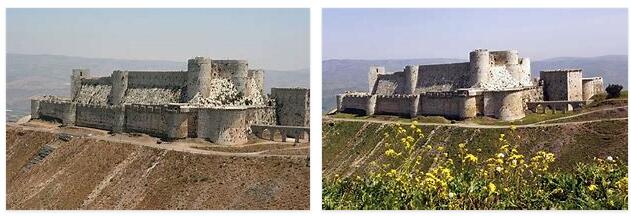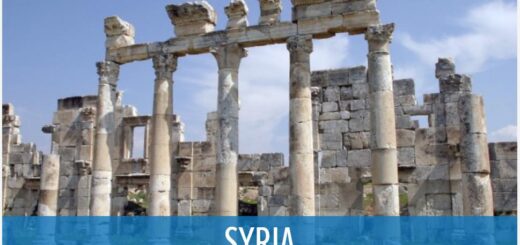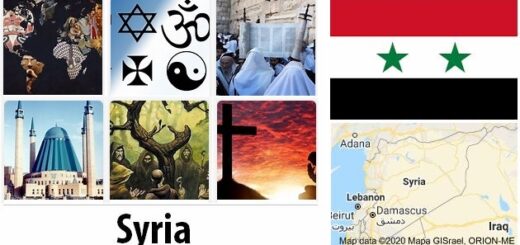Culture and World Heritage Sites in Syria
People lived on the soil of today’s Syria as early as the Stone Age. Between southern Anatolia, Canaan, the Orontes and middle Euphrates crossed in settlements, commercial towns, city and small states as Ebla, Ugarit, Byblos, Qatna, Mari and Carchemish various cultures of the Middle East (influences Babylon culture, Hurriter, Aram), Asia Minor (Hittites), Ancient Egypt and the Aegean Sea. Ruins of palaces, temples, houses, warehouses and citadels as well as wall paintings, reliefs, sculptures and clay tablets (Syrian art) bear witness to this. After the conquest by Alexander the Great n Syria was with Palestine in the Hellenistic included culture. A rich trading city with many representative buildings was until the 3rd century AD. Palmyra on the southern route of the Silk Road. Bosra, once the capital of the Roman province of Arabia, still shines with the remains of colonnaded streets and a Roman theater for 15,000 visitors at the time.
The west of Syria belonged to the early Christianized areas, including the metropolises Antioch (on the Orontes) and Damascus as well as Edessa and the “Dead Cities” in the northern Syrian Karst with their early Byzantine sacred buildings (Simeons monastery). The Syrian language, a branch of Aramaic, is still used today in some Syrian churches for worship. It was also used by Syrian literature, which until well into the Islamic period was mainly religious.
Under the Umayyad caliphs in the 7th and 8th centuries, Byzantine, Arabic and Persian elements developed into an independent canon of forms of Islamic art. It found its expression particularly in the decor: ornaments, frescoes and mosaics. Architectural evidence is z. B. the Dome of the Rock in Jerusalem and the Great Mosque in Damascus, but also caravanserais, palaces and bathhouses (hammam). The Aijubids and Mamluks created imposing fortresses from the 12th / 13th centuries. Century, for example in Aleppo (citadel) and near Latakia (Saladinsburg). They had their counterpart in the crusader castles like that Krak des Chevaliers.
The Arab Bedouin poetry developed in the caliphate, in its cities and courts, into Arabic literature. In the 19th century it was modernized with the addition of European narrative forms. Sakarija Tamer (* 1931) is considered the master of Arabic short stories. Wars, repression and censorship drove many Syrian cultural workers abroad, including the “sad singer” Farid el Atrache (* 1915, † 1974) from Suweida. He made a career in Egypt and set the style for the Arabic music of the 20th century. An internationally known representative of contemporary Arabic pop music is the singer and songwriter George Wassouf from Tartus(* 1961). Only a few Syrian coffeehouses still have the tradition of the oriental »storyteller«.
World Heritage Sites in Syria
World Heritage Sites
- Old City of Damascus (1979)
- Palmyra Ruins (1980)
- Amphitheater and old town of Bosra (1980)
- Old City of Aleppo (1988)
- Crusader castles Krak des Chevaliers and Qalat Salah el-Din (Saladinsburg; 2006)
- Ancient Villages in Northern Syria (2011)
Ancient villages in Northern Syria (World Heritage)
The eight archaeological sites selected include temples, Christian churches, burial sites, bathhouses, apartment buildings, and public buildings. They date from the 1st to the 7th century and give an insight into the way of life and economy of the people.
Ancient villages in Northern Syria: facts
| Official title: | Ancient villages in Northern Syria |
| Cultural monument: | An ensemble of 40 villages from the 1st to 7th centuries (“Dead Cities”, abandoned in the 8th-10th centuries) in eight archaeological parks; Well-preserved landscape in a limestone massif with remains of dwellings, pagan temples, church buildings, cisterns, bathhouses, graves, public buildings etc.; Traces of Roman agricultural production (olives, wine) with irrigation technology and protective walls |
| Continent: | Asia |
| Country: | Syria |
| Location: | approx. 80 km west or south-west of Aleppo |
| Appointment: | 2011 |
| Meaning: | Exceptional testimony to the rural lifestyle in the transition from late antiquity to the Byzantine period; outstanding document of the development of Christianity in village communities in the eastern part of the Roman Empire; Example of village settlement methods in the ancient Middle East |
Crusader castles in Syria (world heritage)
The two medieval castles Krak des Chevaliers and Qalat Salah el-Din (Saladinsburg) are witnesses of the conflict between Christians and Muslims. They are the best preserved fortifications in the Middle East. Krak des Chevaliers was the fortress of the Johanniter until it was stormed in 1271. The Saladinsburg was a Byzantine fortress and was conquered by Saladin in 1118.
Crusader Castles in Syria: Facts
| Official title: | Krak des Chevaliers and Qalat Salah el-Din |
| Cultural monument: | Crusader castles and fortifications in western Syria; Krak des Chevaliers (knight’s fortress, Arabic Kalat el-Hisn): originally Kurdish (from Kurdish »crad«, »kerak«, fortress) by the Order of St. John in 1142 to protect the route to the Holy Land; on a 650 m high hill, difficult to access on three sides, protected by two wall rings with towers; covered corridor from the main entrance on the east side in turns to the inner kennel with chapel, knight’s hall with loggia, refectory and donjon (main and residential tower) of the grand master; Qalat Salah el-Din (Saladinsburg): located on a ridge in Djebel Ansarije; consisting of lower castle and upper castle, surrounded by mighty defensive walls and towers; Artificially created trench 150 m long, 18 m wide and 28 m deep (12th century) to protect the northeast flank; inside the castle remains of buildings from the Byzantine, Norman and Arab times, including ruins of a Byzantine fort and a mosque; partially destroyed today |
| Continent: | Asia |
| Country: | Syria |
| Location: | approx. 80 km west of Homs and approx. 30 km northeast of Latakia |
| Appointment: | 2006 |
| Meaning: | Outstanding examples of fortress and military architecture of the 12th / 13th centuries Century; impressive evidence of the amalgamation of various cultural influences; Documents of the historical presence of the Crusaders in the Orient |
Crusader Castles in Syria: History
| Early 10th century | First written mention of the Qalat Salah el-Din |
| 975 | Conquest of the Qalat Salah el-Din by Emperor Johannes I. Tzimiskes |
| 1108/1109 | Krak des Chevaliers and Qalat Salah el-Din owned by the Crusaders |
| 1142 | The Krak des Chevaliers is taken over by the Order of St. John |
| 1170 | Intensive expansion of Krak des Chevaliers after earthquakes |
| 1188 | Siege and capture of the Qalat Salah el-Din by Sultan Saladin |
| 1271 | Conquest of Krak des Chevaliers by the Mamluk Sultan Baibars I. |
| 1285 | Renewal of the outer wall of the Krak des Chevaliers in the south |
| 20th century | Extensive restoration work on Krak des Chevaliers |



